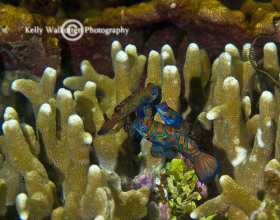KELLY WALKOTTEN PHOTOGRAPHY
|
Mandarin Fish, (Synchiropus splendidus), are found in Malaysia, Indonesia, the Philippines, and Australia. I found these colorful jewels of the sea in the Northern Sulawesi diver’s paradise of Bunaken and the Lembeh Strait. These small fish (1 to 2 inches) are strikingly beautiful with their body designs of squiggles, swirls, dots, and stripes in bright colors of orange, green, blue, and yellow. Their name comes from the resemblance to the robes of Imperial Chinese officers known as mandarin. These beautiful fish are members of the dragonete family. Mandarin fish are dimorphic, which means they can accomplish the sexual and reproductive traits of either, if they lack mates of the opposite sex. The males typically have more orange color on their faces, and larger bodies, while the females have smaller dorsal fins. Even with their distinctive markings, mandarin fish are very difficult to locate in their native habitat. 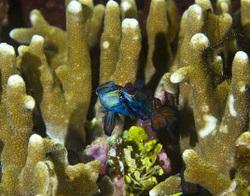 Mandarin fish are difficult to locate because they are extremely shy. They live in pairs and in groups of up to five, living at depths of 4 to 60 feet . They prefer to live on fringing reefs and slopes, inhabiting broken coral rubble beds, in sheltered lagoons. Both movement and lights will scare them back into their coral habitat, which makes them very difficult to photograph. Because they are so shy, we arrived early to get into position, so that we were ready to photo when the action began and not scare them back into the reef. 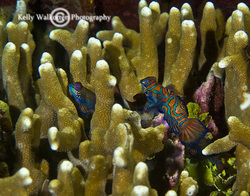 Mandarin fish are elusive during the day, but if a diver is patient, they can be seen perched on or darting between coral branches. Swimming by rapidly pulsating their fins makes them appear to hover, much like a humming bird. Mandarin fish have a broad and depressed head. They have four dorsal spines, eight dorsal soft rays and no anal spines. The males are larger than the females and have an elongated first dorsal spine. Their big outward-set eyes are ideal for food hunting and feeding in the dim light conditions found underwater. 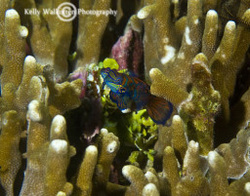 The Mandarin Fish is one of the few types of fish who do not have scales. The fish are instead protected by a thick mucus-coated slimy and smelly skin. This coating helps protect them from parasites, and discourages predators because of their foul taste. The bright, vivid coloration also serves as a warning to predators of their bad smell and taste. Not much is known about their predators, but scorpion fish have been known to lie in wait to attack an unsuspecting mandarin fish during their mating ritual. Mandarin fish reproduce by releasing thousands of eggs into the ocean after a courtship consisting of a “mating dance.” The dance frequently is ended by the female before spawning has occurred, requiring several attempts to complete the process. This mating ritual occurs each evening before sunset. 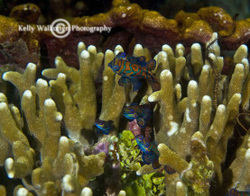 Within twenty minutes of sunset every evening, three to five females will gather at a particular area of the reef. The males will visit, displaying courtship behavior, in hopes of attracting the females. The males are known to tour around to the different sites, mating with several females in an evening. The female will rest on the pelvic fin of the chosen male. The pair will slowly raise about one foot up from the reef, belly to belly, and at the peak of their assent a cloud of sperm and eggs (around 200 eggs) are released into the water. The fish then disappear, instantly darting back into the coral. All of this takes place in a matter of seconds. A camera with low light capabilities will help when trying to capture the action. The fertilized eggs are spread by the current and will hatch in 18-24 hours. They hatch into larvae about one eight of an inch and will remain plankton for up to two weeks. Then they settle onto the reef and choose an appropriate habitat where they will reside. Mandarin fish are among the smallest ocean fish that spawn. An average life span is 10 to 15 years. Because only a small number of females within a group are active, competition for the males is high. Females seem to prefer the bigger and stronger males and therefore the larger males mate more often than the smaller ones. Because the smaller males don’t mate as often, they have been known to rush up on a mating pair releasing sperm in hopes of random fertilization. 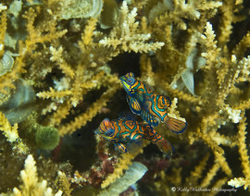 After participating in a Mandarin dive, making the choice of sitting on the dock watching the sun set with a Pina Colada in hand or jumping in to watch the show was an easy one. If you are ever in an area where Mandarin Fish live, take the opportunity to see the beautiful colors and to watch the mating process. When you can find them, it is a good show. |
Categories
All
Kelly WalkottenI am a nature, wildlife and underwater photographer. I love to travel and capture the story. Archives
October 2020
Other Cool SitesHunts Photo is offering 10% off of all Red River Paper to my followers. I personally use and love Red River Paper!
|

